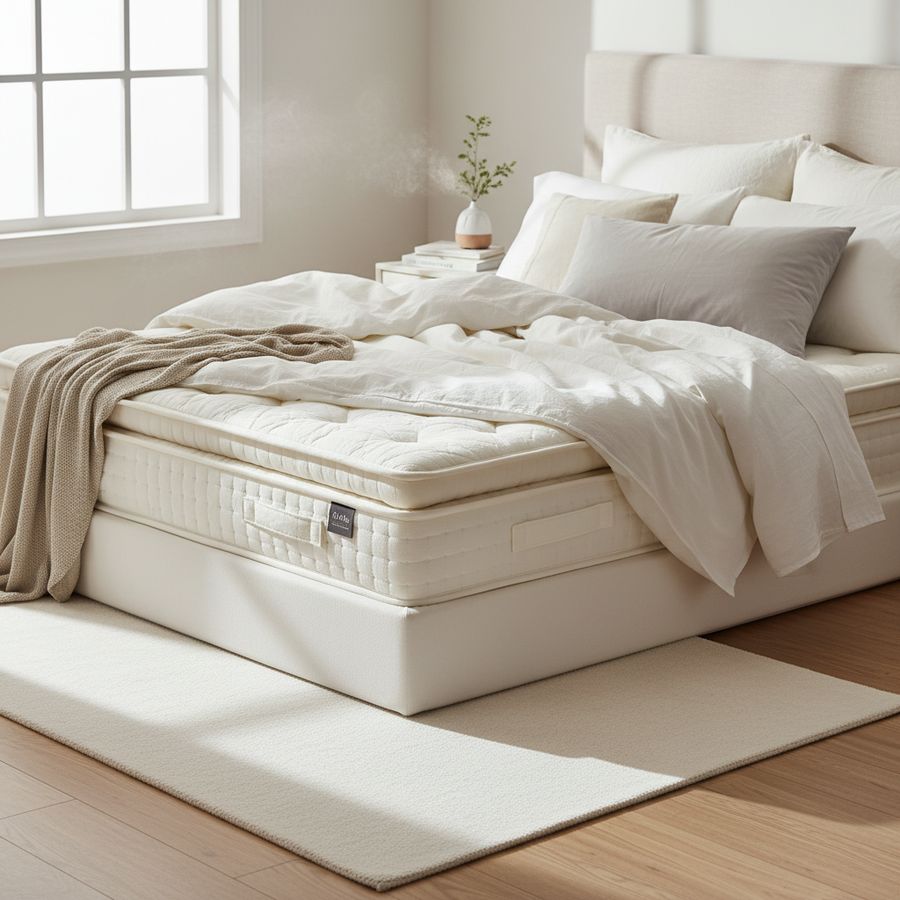The Impact of Mattress Materials on Sleep Quality and Health
Overview
Choosing the right mattress is essential for achieving optimal sleep quality and maintaining overall mattress health. The materials used in mattress construction play a pivotal role in determining comfort, support, durability, and the impact on your wellbeing. At Carter & Lewis, we understand that a mattress is more than just a place to rest—it is a foundation for restorative sleep and long-term health.
The diversity of mattress materials available today can be overwhelming, ranging from natural fibers to advanced synthetic foams. Each material boasts unique characteristics that influence how well a mattress supports the body, regulates temperature, and resists allergens. Knowing these differences empowers consumers to select a mattress tailored to their personal needs and preferences.
Sleep quality depends heavily on how a mattress supports your body’s natural alignment and how comfortable it feels through the night. An ideal mattress material balances softness with firm support, ensuring pressure points like shoulders, hips, and lower back are properly cushioned without sagging or stiffness. Additionally, the breathability and hypoallergenic properties of mattress components can enhance the sleeping environment by reducing moisture and allergens.
"A mattress is not just furniture; it's the foundation of restful sleep, health, and well-being."
Understanding mattress materials also includes considering sustainability and environmental impact. Many consumers today prefer natural materials that are renewable and chemical-free, aligning with a growing commitment to eco-friendly lifestyles. Conversely, some synthetic materials offer advanced technologies for enhanced comfort but may have different environmental footprints.
In this article, we will explore the most common mattress materials, how they affect comfort and support, compare natural versus synthetic options, discuss health considerations, and provide guidance on selecting the right material to improve your sleep quality and overall health.

Common Mattress Materials
Mattresses are crafted from a variety of materials, each offering distinct benefits and challenges. Understanding these common materials can help you appreciate the craftsmanship behind premium mattresses and make a more informed choice.
Innerspring Coils: Traditional mattresses often use steel coils for support. These provide firm, responsive support and good airflow but may lack contouring comfort. Modern designs, such as pocket springs, isolate motion and enhance support zones.
Memory Foam: This viscoelastic material conforms closely to the body, alleviating pressure points and offering excellent motion isolation. Memory foam mattresses are popular for their contouring ability but can retain heat if not designed with cooling technologies.
Latex: Available as natural or synthetic, latex is resilient and breathable. Natural latex, derived from rubber trees, is prized for its durability, bounce, and hypoallergenic properties. It offers a responsive feel and excellent support while maintaining airflow.
Natural Fibers: Materials such as wool, cotton, and cashmere are often used in mattress covers or padding layers. They contribute to moisture-wicking, temperature regulation, and a luxurious feel. These fibers are sustainable and reduce exposure to synthetic chemicals.
High-Density Foams and Reflex Foam: These foams provide foundational support and durability. Reflex foam, in particular, is firm and resilient, making it ideal for orthopaedic mattresses targeting back support.
- Hybrid mattresses combine these materials—such as memory foam and pocket springs—to offer balanced comfort and support.
- Specialty foams with cooling gels or open-cell structures enhance breathability.
Each of these materials plays a crucial role in the overall sleep experience. For example, Carter & Lewis mattresses often blend natural latex with advanced memory foams and innersprings, delivering a sophisticated balance of comfort, support, and health benefits.

Effects on Comfort and Support
The choice of mattress materials directly influences how comfortable and supportive a mattress feels, which in turn impacts your sleep quality and spinal health. Comfort and support are intimately connected but distinct aspects of mattress performance.
Comfort relates to the immediate feel of the mattress surface—its softness, temperature regulation, and pressure relief. Materials like memory foam and natural latex are renowned for their ability to cradle the body, contouring to curves and alleviating tension at shoulders, hips, and joints. This cushioning effect reduces tossing and turning, promoting deeper, uninterrupted sleep.
Support refers to the mattress’s capacity to maintain proper spinal alignment by evenly distributing body weight. Innerspring coils, high-density foams, and rigid latex layers provide this essential firmness. Without adequate support, the body may sag or bend unnaturally, leading to discomfort and chronic pain.
Premium mattresses, such as those offered by Carter & Lewis, often incorporate advanced multi-zone support systems. These systems vary firmness in different mattress areas to provide gentle cushioning where needed and firmer support for the lumbar region. This targeted approach promotes healthy posture during sleep, especially beneficial for those with back pain or orthopedic concerns.
"The advanced five-zone support system targets different body areas with varying levels of firmness, providing gentle cushioning for shoulders and hips while firmly supporting your lower back."
Temperature regulation also affects comfort. Materials like wool and natural latex naturally wick away moisture and allow airflow, preventing overheating. Memory foam mattresses, while comfortable, benefit from gel infusions or ventilation technologies to enhance breathability.
Ultimately, the best mattress material combination depends on your personal preferences, body type, and health needs. Prioritizing both comfort and support ensures restorative sleep, reduces pain, and improves overall wellbeing.
Natural Vs Synthetic Materials
The debate between natural materials and synthetic alternatives in mattress construction involves considerations of health, environmental impact, comfort, and longevity. Both types have unique advantages and potential drawbacks.
Natural materials include organic cotton, wool, cashmere, and natural latex. These materials are prized for their breathability, sustainability, and hypoallergenic properties. For instance, wool naturally repels dust mites and regulates temperature by wicking moisture away from the body, creating a healthier sleep environment.
Natural latex, sourced from rubber trees, offers a resilient and durable support layer that adapts to body contours while maintaining airflow. Mattresses crafted with natural fibers and latex often appeal to eco-conscious consumers seeking chemical-free sleep surfaces and sustainable production methods.
Synthetic materials such as memory foam, polyurethane foams, and polyester fabrics excel in engineered performance features. Memory foam molds to the sleeper’s shape, providing excellent pressure relief and motion isolation. Synthetic foams can also be infused with cooling gels or designed with open-cell structures to improve airflow and temperature regulation.
However, synthetic materials may off-gas volatile organic compounds (VOCs) initially and sometimes retain heat without adequate ventilation. Moreover, they generally have a higher environmental footprint in production and disposal compared to natural options.
- Natural materials often require more careful maintenance to prevent moisture buildup.
- Synthetic materials may offer cost advantages and innovative performance features.
Choosing between natural and synthetic mattress materials depends on your priorities. If you value sustainability, allergy resistance, and natural comfort, mattresses like the Carter & Lewis Natural Comfort Mattress may be ideal. If you seek advanced contouring and orthopaedic support, high-quality memory foam or hybrid designs can provide exceptional benefits.
Health Considerations
The materials in your mattress profoundly affect your health, influencing allergy symptoms, spinal health, and overall sleep quality. Understanding these health considerations can help you select a mattress that supports your wellbeing.
Hypoallergenic properties are critical for people prone to allergies or asthma. Natural fibers like wool and cotton are naturally resistant to dust mites and mold, reducing triggers in the sleeping environment. Many premium mattresses now feature hypoallergenic, antimicrobial covers to further protect against allergens.
Support for spinal alignment is essential to prevent and alleviate back pain. Mattresses with well-engineered support layers ensure that the spine remains neutral during sleep, reducing muscle strain and nerve compression. Orthopaedic mattresses, including those with high-density foams and zoned pocket springs, are designed specifically to promote healthy posture.
"Experience superior comfort and targeted back support with the Carter & Lewis HyCare Ortho Mattress, expertly designed for back pain sufferers and all sleeper types seeking restorative rest."
Breathability and temperature control also impact health by preventing night sweats and improving sleep continuity. Natural materials and breathable mattress constructions minimize moisture build-up, creating a drier, healthier surface less conducive to bacteria and fungi.
Some synthetic materials may release low levels of chemicals initially, a factor to consider if you are sensitive to indoor air quality. Certified organic or eco-friendly mattresses reduce exposure to synthetic chemicals and flame retardants.
Ultimately, a mattress that combines supportive materials with natural, breathable, and hypoallergenic components offers the best foundation for both comfort and long-term health.
Selecting the Right Material
Choosing the right mattress material involves balancing comfort preferences, health needs, and lifestyle considerations. Here are key factors to guide your selection process:
- Body Support Needs: If you require firm support for back pain, look for mattresses with high-density foams, pocket springs, or natural latex featuring zoned support.
- Comfort Preferences: Those who prefer a plush, contouring feel may benefit from memory foam or natural latex layers that relieve pressure points effectively.
- Allergy and Sensitivity: Opt for natural, hypoallergenic materials like wool and organic cotton if you suffer from allergies or respiratory issues.
- Temperature Regulation: Choose breathable materials such as wool, latex, or ventilated foams to avoid overheating during sleep.
- Environmental Considerations: Eco-conscious shoppers should consider mattresses using sustainable natural materials and certified organic textiles.
Many Carter & Lewis mattresses expertly combine these factors, such as the Memory Collection Mattress that integrates advanced orthopaedic support with natural latex and breathable covers for a balanced sleep experience. Evaluating mattress samples, reading detailed product descriptions, and consulting expert guides can further aid your decision.
Remember, your mattress is an investment in your health and quality of life. Taking the time to select the right materials ensures that you enjoy restorative, comfortable nights and wake up refreshed and pain-free.
Conclusion
The impact of mattress materials on sleep quality and mattress health cannot be overstated. From the foundational support of innerspring coils and high-density foams to the luxurious comfort of natural latex and breathable fibers, every material contributes uniquely to your sleep environment.
Choosing the right combination of materials is crucial for achieving the ideal balance of comfort, support, and health benefits. Natural materials offer sustainability and hypoallergenic advantages, while synthetic materials provide advanced contouring and innovative performance features. Understanding these differences empowers you to make an informed choice tailored to your personal needs.
"Carter & Lewis mattresses combine timeless craftsmanship with modern innovation to cradle every dreamer in luxurious, restorative rest."
As a family business rooted in Yorkshire heritage, Carter & Lewis is dedicated to crafting premium mattresses that deliver exceptional comfort, orthopaedic support, and lasting durability. By selecting a mattress thoughtfully designed with the right materials, you invest in not just a better night’s sleep, but also enhanced health and wellbeing for years to come.
